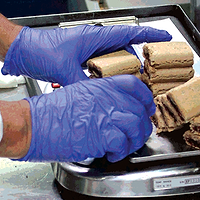Hepatitis A Exposure among Foodservice Workers

A record hepatitis A outbreak in Kentucky has indicated that foodservice workers (FSWs) have been largely overlooked as an exposed group. While FSWs have not typically been considered to have an elevated risk of infection by some authorities, data specific to the occupational exposure of FSWs to hepatitis A are limited. Additionally, meaningful guidance for the protection of FSWs from occupational infection is lacking. These factors, along with the substantial economic burden faced by FSWs should they become infected, support the need to consider these employees at risk of occupational exposure and infection, to develop and provide specific guidance for their protection, and to conduct better surveillance on their exposures and infections.
Overview: The Risk to Foodservice Workers
This outbreak of hepatitis A in Kentucky has heightened attention on the control and prevention of this disease. While the state has typically averaged around 20 acute cases annually, a dramatic increase occurred in 2017, prompting the Kentucky Department of Public Health to declare a statewide outbreak.[1] On June 28, 2018, officials reported it to be the most severe outbreak on record for both the state and country, with the count up to 969 cases.[2] The majority of cases were reported in Jefferson County,[3] home to the city of Louisville. Groups affected by the outbreak include homeless persons, drug users, and healthcare providers.[4,5]
This review focuses specifically on FSW exposure to hepatitis A. Specific instances of FSWs affected by the outbreak include employees of Old Chicago Pizza, Hard Rock Café, and Panera Bread.[6–8] Arkansas and Indiana have reported recent cases among restaurant workers as well.[9] Cases such as these and a review of associated literature indicate the need for a greater emphasis on protecting FSWs from occupational exposure to hepatitis A.
What Do We Know?
Hepatitis A viruses are shed in the feces of infected persons and then find their way to other hosts through a range of unhygienic pathways.[10] Person-to-person transmission through the fecal-oral route is considered the primary mode of infection in the United States, with exposure to contaminated food or water a common cause of outbreaks.[11] The U.S. Centers for Disease Control and Prevention (CDC)’s National Outbreak Reporting System notes that from 2000 to 2016, there averaged about three outbreaks of foodborne hepatitis A per year nationally.[12] A foodborne outbreak in 2016 resulted from frozen strawberries imported from Egypt and distributed to California, New Jersey, New York, and Texas.[13] Infection through imported foods is a concern for other countries as well, as demonstrated by a recent outbreak in the Netherlands attributed to a raspberry/blueberry product originating from a producer in Bulgaria.[14] With the global food trade projected to increase, the likelihood of a corresponding increase in foodborne illnesses should be anticipated.[15]
Control Efforts via Public Health Campaigns
Substantial public health campaigns have been undertaken toward hepatitis A prevention internationally and domestically. The World Health Organization collects and disseminates internationally oriented information on geographic distribution, transmission, symptoms, risk groups, guidance, and other key points.[16] Within the U.S., CDC provides similar functionality, gathering and issuing information tailored toward both health professionals and the public in the form of guidelines, statistics, and surveillance among other information (see “A Plan for Protection for Foodservice Workers,”[17] below).[18] CDC has specifically recommended hepatitis A vaccination for all children upon reaching 1 year of age, residents of communities and households with high infection rates, illegal drug users, men who have sex with other men, travelers to countries with high infection rates, persons with chronic liver disease, and those working with infected animals.[19]
The public health alert issued in response to Kentucky’s outbreak promoted vaccination in general, washing hands, and cooking food thoroughly as key strategies to guard against infection.[20] As part of control efforts, CDC epidemiologists determined that the viral strain and genotype found in infected persons in Louisville were identical to those found in California and Utah outbreaks.[21] Other public health regions were notified to guard against subsequent outbreaks and ensure the availability of adequate vaccine supplies for at-risk populations.[22]
Several nonmandatory vaccination efforts were launched in response to the outbreak, including the Louisville Metro Department of Public Health and Wellness (LMDPHW)’s administration of nearly 5,000 immunizations at homeless shelters, syringe exchange sites, and a correctional facility.[23] The LMDPHW also partnered with the University of Louisville Global Health Center to offer vaccinations to foodservice and hospitality workers at the subsidized cost of $25.[24] Private-sector efforts targeting FSWs range from offerings of free immunizations to employees[25] to the implementation by McDonald’s of a mandatory policy.[26] Although vaccination of FSWs as a group has not been broadly recommended,[27] a mandatory vaccination policy for all FSWs was shown to be effective at reducing infections in St. Louis County, Missouri.[28] Vaccination or immunoglobulin administration as postexposure prophylaxis is recommended irrespective of occupation.[29]
Problems with Data on FSWs
Certainly, FSWs have experienced hepatitis A infection,[30,31] but it is difficult to determine whether the infections originated from occupational or nonoccupational exposures. Occupational infections should be understood to be those that occurred solely due to the infected individual’s participation in a work-related activity. Two foreseeable routes of occupational infection of FSWs are from the inadvertent ingestion of fecal material carried on food either: 1) after handling the contaminated food or 2) after contacting a contaminated surface in a food preparation area.
The only occupational groups designated by CDC to be at increased risk of infection are persons working with infected primates and those working with hepatitis A virus in a research setting.[11] However, although FSWs have not been designated as being at increased risk, this should not be construed to mean they are free of risk. Indeed, data gathered on outbreaks associated with infected FSWs indicate that some employees were most likely infected during the course of their work[32] and that transmission between coworkers had occurred.[33] Other studies suggest that occupational groups at elevated risk also include day care providers, hospital workers who have direct patient contact, and sewage workers.[34,35] Lerman et al.[36] included FSWs among those occupations considered at elevated risk, along with teachers and others.
Relatively few data are available through existing public health surveillance sources regarding cases of hepatitis A that have been contracted through occupational exposures. Keeffe noted that there is a “paucity of epidemiologic data regarding occupational risk to HAV, particularly in the United States.”[35] Data gathered by CDC on hepatitis A cases that consider occupational exposure are minimal. Infected persons who are employed in a nursery, day care, or preschool are distinguished, but these data are of limited utility because they aggregate the employment identifier together with the identifier of attendance at these establishments.[37]
The U.S. Bureau of Labor Statistics (BLS) gathers occupationally oriented data on cases of infectious disease from employers annually. Reported cases of hepatitis A must meet recording criteria set by the Occupational Safety and Health Administration (OSHA), generally described as being work-related, resulting in an infection, and resulting in the infected employee missing work or being placed on restricted work duty for at least one day.[38] A search of the BLS’s Occupational Injury and Illness Profiles database for case and demographic profiles, 2011–2016, nature-of-condition characteristic, subcharacteristic viral hepatitis, across all ownerships, indicated that no such cases had been reported.[39] This may seem puzzling in light of indications discussed here that hepatitis A infections have occurred among employees, but BLS data have been noted to suffer significantly from underreporting.[40] BLS data reliability relative to hepatitis A cases may be further challenged in light of the estimate that approximately 24 percent of cases may not be identified due to being asymptomatic.[41]
Safety Guidance for FSWs Is Sparse
Like data on occupational exposures, the guidance and information on hepatitis A specific to FSWs are substantially deficient. OSHA, the preeminent authority on employee safety and health, makes scant mention of hepatitis A on its website,[42] and the agency’s training module on youth worker safety in restaurants does not address the hazards associated with foodborne illnesses.[43] Meanwhile, more substantive guidance issued by public health authorities is oriented toward preventing the transmission of hepatitis A in general, rather than protecting any particular employee group.[44–46] Other informational sources, such as recommendations issued by the U.S. Food and Drug Administration’s Center for Food Safety and Applied Nutrition (CFSAN),[47] are tailored to the foodservice industry rather than industry workers.
Infection’s Financial Impact on FSWs
Fortunately, the common symptoms of hepatitis A such as nausea, vomiting, and diarrhea are transient and do not typically lead to chronic liver disease, and deaths from complications are rare.[48] However, infection can pose a serious economic burden for FSWs stemming from resultant unemployability. Infected FSWs may quickly find themselves without income, as CFSAN has called for symptomatic employees to be removed from work immediately and prevented from returning to work no sooner than 24 hours following the cessation of vomiting and diarrhea, and to be off work for up to 30 days if serving highly susceptible populations.[47] Likewise, literature issued by the Food Marketing Institute has recommended removing infected employees from work until released by a physician or public health department.[49] Discharge from work can be a very significant consequence for FSWs, since lost income due to infection has been estimated at $2,500 per worker, excluding medical costs.[50]
Conclusion
In light of their potential occupational exposure, the significant economic impact following infection, and lack of solid data and applicable guidance, it is clear that safeguarding FSWs from hepatitis A should be given more attention than is the case currently. Short of their universal vaccination as an occupational group, efforts should be undertaken to ensure that: 1) improved surveillance of occupational exposures and infections of FSWs is conducted by responsible authorities; 2) FSWs are considered at risk of infection as a function of their work by authorities and employers; and 3) occupationally oriented approaches are incorporated into efforts intended to protect their health. A subsequent article will review control methodologies tailored to protect FSWs from occupational exposures to hepatitis A, should vaccination not occur.
David Stumbo, Ed.D., OHST, is an associate professor in Eastern Kentucky University’s Department of Safety, Security, and Emergency Management. He has worked in occupational safety and health for over 20 years, including various positions within the Kentucky OSH Program. Rifath Ali, M.D., M.P.H., M.Sc., is adjunct faculty at Eastern Kentucky University. Rifath's 13 years of professional, diverse experience includes being a practicing physician in India, public health specialist, and environmental health and safety education and training specialist.
References
1. www.cnn.com/2018/05/01/health/hepatitis-a-kentucky-indiana-bn/index.html.
2. www.wsaz.com/content/news/400-hepatitis-A-cases-reported-in-Kentucky-as-outbreak-enters-16th-week-481151851.html.
3. kyrha.org/resources/Documents/Hepatitis A Outbreak Brief Update.pdf.
4. nkyhealth.org/2018/06/04/northern-kentucky-health-department-launches-hepatitis-a-outbreak-prevention-plan/.
5. www.cdc.gov/hepatitis/outbreaks/2017March-HepatitisA.htm.
6. foodpoisoningbulletin.com/2018/employees-two-louisville-kentucky-restaurants-diagnosed-hepatitis/.
7. www.wdrb.com/story/38117184/employee-of-hard-rock-cafe-at-4th-street-live-diagnosed-with-hepatitis-a.
8. www.wdrb.com/story/38087899/employee-at-marks-feed-store-and-panera-locations-in-louisville-diagnosed-with-hepatitis-a.
9. www.foodsafetynews.com/2018/04/more-restaurant-workers-with-hepatitis-a-vaccinations-urged/#.Wz0nQdJKjIU.
10. Polish, L, et al. 1999. J Clin Microbiol 37(11):3615–3617.
11. www.cdc.gov/hepatitis/hav/havfaq.htm.
12. wwwn.cdc.gov/norsdashboard/.
13. www.cdc.gov/hepatitis/outbreaks/2016/hav-strawberries.htm.
14. link.springer.com/article/10.1007/s12560-018-9347-3.
15. Hussain, M and O Dawson. 2013. Foods 2(4):585–589.
16. www.who.int/news-room/fact-sheets/detail/hepatitis-a.
17. Todd, E, et al. 2010. J Food Prot 73(9):1762–1773.
18. www.cdc.gov/hepatitis/hav/index.htm.
19. www.mdedge.com/jfponline/article/155079/vaccines/cdc-provides-advice-recent-hepatitis-outbreaks.
20. www.foodsafetynews.com/2017/11/hepatitis-a-outbreak-reaches-kentucky-vaccine-running-low/#.WsYH2IjwYdU.
21. www.courier-journal.com/story/news/local/2018/03/06/hepatitis-death-louisville-kentucky-kroger/397026002/.
22. www.cdc.gov/hepatitis/outbreaks/InterimOutbreakGuidance-HAV-VaccineAdmin.htm.
23. www.precisionvaccinations.com/hepatitis-virus-kentucky-genetically-matched-california-and-utah.
24. insiderlouisville.com/health/will-low-cost-shots-for-restaurant-workers-beat-hepatitis-a/.
25. www.whas11.com/article/news/health/louisville-bearnos-pizza-employee-diagnosed-with-hepatitis-a-virus/417-546675194.
26. www.foodsafetynews.com/2018/05/restaurants-finally-vaccinating-employees-against-hepatitis-a/#.W0IjttIzodW.
27. Fiore, A, et al. 2006. MMWR 55(RR-7):1–23.
28. Rebmann, T, et al. 2016. AIMS Public Health 3(1):116–130.
29. www.cdc.gov/vaccines/pubs/pinkbook/hepa.html.
30. Sharapov, U, et al. 2016. Public Health Rep 131(1):26–29.
31. Tricco, A, et al. 2006. BMC Health Serv Res 6(1).
32. U.S. Centers for Disease Control and Prevention. 2003. MMWR 52(47):1155–1157.
33. Fiore, A. 2004. Clin Infect Dis 38(5):705–715.
34. Brugha, R, et al. 1998. Occup Environ Med 55(8):567–569.
35. Keeffe, E. 2004. J Clin Gastroenterol 38(5):440–448.
36. Lerman, Y, et al. 1999. Am J Epidemiol 150(3):312–320.
37. www.cdc.gov/hepatitis/statistics/2016surveillance/pdfs/2016HepSurveillanceRpt.pdf.
38. www.osha.gov/laws-regs/standardinterpretations/1993-04-02-0.
39. data.bls.gov/gqt/InitialPage.
40. Fagan, K and M Hodgson. 2017. J Safety Res 60:79–83.
41. Lednar, W, et al. 1985. Am J Epidemiol 122(2):226–233.
42. www.osha.gov/SLTC/foodbornedisease/index.html.
43. www.osha.gov/SLTC/foodbornedisease/index.html.
44. www.dhhs.nh.gov/dphs/fp/documents/hepatitisa.pdf.
45. www.michigan.gov/documents/mdhhs/Poster_-_Important_HAV_Info_for_Food_Employees_605606_7.pdf.
46. www.doh.wa.gov/CommunityandEnvironment/Food/FoodWorkerandIndustry/HepatitisA.
47. www.fda.gov/Food/GuidanceRegulation/RetailFoodProtection/IndustryandRegulatory
AssistanceandTrainingResources/ucm113827.htm#employee_health.
48. Matheny, S and J Kingery. 2012. Am Fam Physician 86(11):1027–1034.
49. www.fmi.org/docs/default-source/food-safety-best-practice-guides/hepatitis-a-guide.pdf?sfvrsn=4.
50. Bownds, L, et al. 2003. J Community Health 28(4):233–246.
Looking for a reprint of this article?
From high-res PDFs to custom plaques, order your copy today!








